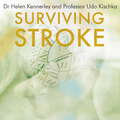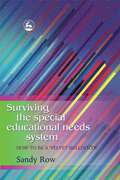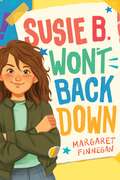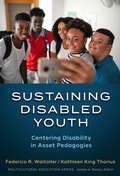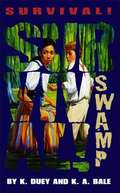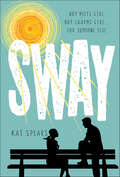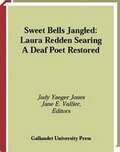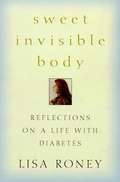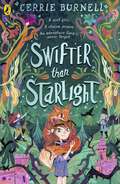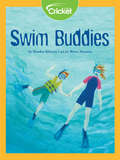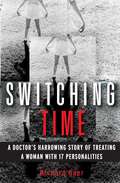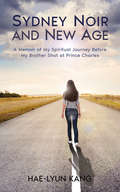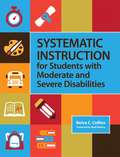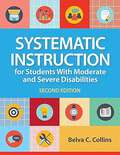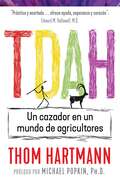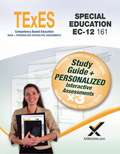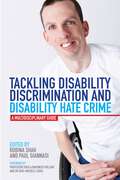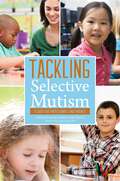- Table View
- List View
Survival Strategies for Going Abroad: A Guide for People with Disabilities
by Laura HersheyThis easy-to-use guide addresses the disability-related aspects of going on an international exchange, including choosing a program, applying, preparing to travel, adjusting to life in a new country, and returning home.
Surviving Stroke: The Story of a Neurologist and His Family
by Helen Kennerley Udo KischkaIn October 2016, Udo Kischka suffered a severe stroke. A large intra-cerebral bleed, a bleed deep in the right side of his brain. He was not a typical stroke patient: Professor Kischka was a neurologist and specialist in stroke rehabilitation. Like all stroke patients, he embarked on a journey of recovery. In his case, it was a re-education in his field of expertise. When he uttered the words, 'This is a life changing event' to his wife a few hours after the stroke, he had no idea just how life changing it would be or that there would be still be a good life to be had. Written by experts on both sides of the fence - a stroke victim who is a stroke specialist, and a psychologist who helps others and now has to help herself and her family - this is a personal and brutally honest story of a family's survival. This accessible and relatable book provides insight and realistic hope about what might lie ahead following a stroke, as well as offering both practical and emotional support.
Surviving Stroke: The Story of a Neurologist and His Family
by Helen Kennerley Udo KischkaIn October 2016, Udo Kischka suffered a severe stroke. A large intra-cerebral bleed, a bleed deep in the right side of his brain. He was not a typical stroke patient: Professor Kischka was a neurologist and specialist in stroke rehabilitation. Like all stroke patients, he embarked on a journey of recovery. In his case, it was a re-education in his field of expertise. When he uttered the words, 'This is a life changing event' to his wife a few hours after the stroke, he had no idea just how life changing it would be or that there would be still be a good life to be had. Written by experts on both sides of the fence - a stroke victim who is a stroke specialist, and a psychologist who helps others and now has to help herself and her family - this is a personal and brutally honest story of a family's survival. This accessible and relatable book provides insight and realistic hope about what might lie ahead following a stroke, as well as offering both practical and emotional support.
Surviving Stroke: The Story of a Neurologist and His Family
by Helen Kennerley Udo KischkaIn October 2016, Udo Kischka suffered a severe stroke. A large intra-cerebral bleed, a bleed deep in the right side of his brain. He was not a typical stroke patient: Professor Kischka was a neurologist and specialist in stroke rehabilitation. Like all stroke patients, he embarked on a journey of recovery. In his case, it was a re-education in his field of expertise. When he uttered the words, 'This is a life changing event' to his wife a few hours after the stroke, he had no idea just how life changing it would be or that there would be still be a good life to be had. Written by experts on both sides of the fence - a stroke victim who is a stroke specialist, and a psychologist who helps others and now has to help herself and her family - this is a personal and brutally honest story of a family's survival. This accessible and relatable book provides insight and realistic hope about what might lie ahead following a stroke, as well as offering both practical and emotional support.
Surviving an Eating Disorder: New Perspectives and Strategies for Family and Friends
by Margot Weinshel Michele Siegel Judith BrismanFrom the book: The first book of its kind, Surviving an Eating Disorder is an inspiring yet realistic guide written expressly for parents, spouses, friends, relatives, and all others who are the "silent sufferers" of anorexia, bulimia, and compulsive overeating. Whether you've just begun to suspect a problem or have been facing the frightening reality of a serious disorder for some time, this reassuring book will help you to overcome feelings of confusion, helplessness, and anger and to take new actions that will encourage the recovery process. The authors, three leading experts in the field, explain what you can expect from the eating-disordered person--and yourself---and what kind of support is available. Drawing on the authors' extensive experience in counseling individuals, groups, and families, and illustrated throughout with vivid case examples, Surviving an Eating Disorder will help answer all your questions, large and small: Why is this happening? Can I keep sweets in the house? What do I say when she asks if she looks fat? How can I help him with his diet? Should I suggest therapy? Will things get better? In Part I, "Gaining Perspective," the authors discuss the psychological components of eating disorders as well as the family contexts in which they develop. Part II, "Confronting the Problem," offers guidance for bringing the problem out into the open, getting the person into treatment, and coping with the possibility of anger and denial. In Part III, "Using New Strategies," the authors show how the situation can be made better--now--by disengaging from the eating disorder (with practical suggestions for handling such daily issues as mealtimes, messy bathrooms, money, and requests for advice) while reestablishing a relationship with the eating disordered person based on issues other than food and weight. The guide concludes with names and addresses of national organizations and a list of suggested readings.
Surviving the Special Educational Needs System: How to be a ‘Velvet Bulldozer'
by Sandy RowSome children's 'difficulties' do not present in an obvious way, which makes diagnosis problematic, and access to help unforthcoming. This was the experience of Sandy Row, who, after a decade of misdiagnoses and unsatisfactory explanations for her children's struggle in mainstream school, realised that her children had special educational needs (SEN) and began her long quest for help from the SEN system. Row's testimony illustrates how the special educational needs system works and empowers other parents to demand help for their children who have special educational needs that require attention. This frank and practical book challenges the theoretical and often impenetrable established literature on SEN, and instead provides an accessible and effective resource for those needing advice and answers about their rights to services and help for their children.
Susie B. Won't Back Down
by Margaret FinneganRoll with It meets Absolutely Normal Chaos in this funny, big-hearted novel about a young girl’s campaign for student council president, told through letters to her hero Susan B. Anthony. <p><p> Susie B. has a lot to say. Like how it’s not fair that she has to be called Susie B. instead of plain Susie. Or about how polar bears are endangered. Or how the Usual Geniuses are always getting picked for cool stuff over the kids like her with butterflies in their brain. And it’s because Susie B. has a lot to say about these very important things that she’s running for student council president! If she’s president, she can advocate for the underdogs just like her hero and fellow Susie B., Susan B. Anthony. (And, okay, maybe the chance to give big speeches to the whole school with a microphone is another perk.) But when the most usual of Usual Geniuses also enters the student council race, Susie realizes this may be a harder won fight than she thought. <p><p> Even worse, Susie discovers that Susan B. Anthony wasn’t as great as history makes it seem, and she did some pretty terrible things to try to help her own cause. Soon, Susie has her own tough decisions to make. But one thing is for sure—no matter what, Susie B. won’t back down.
Sustaining Disabled Youth: Centering Disability in Asset Pedagogies (Multicultural Education Series)
by Frederico R. Waitoller Kathleen A. King ThoriusAsset-based pedagogies, such as culturally relevant/sustaining teaching, are frequently used to improve the educational experiences of students of color and to challenge the White curriculum that has historically informed school practices. Yet asset-based pedagogies have evaded important aspects of students’ culture and identity: those related to disability. <P><P> Sustaining Disabled Youth is the first book to accomplish this. It brings together a collection of work that situates disability as a key aspect of children and youth’s cultural identity construction. It explores how disability intersects with other markers of difference to create unique cultural repertoires to be valued, sustained, and utilized for learning. <P><P>Readers will hear from prominent and emerging scholars and activists in disability studies who engage with the following questions: Can disability be considered an identity and culture in the same ways that race and ethnicity are? How can disability be incorporated to develop and sustain asset-based pedagogies that attend to intersecting forms of marginalization? How can disability serve in inquiries on the use of asset-based pedagogies? Do all disability identities and embodiments merit sustaining? How can disability justice be incorporated into other efforts toward social justice?
Swamp: Bayou Teche, Louisiana 1851 (Survival!)
by Kathleen Duey Karen A. BaleBayou Teche, 1851No one in Lily LeGrand's Cajun community is willing to help search for Paul Courville, missing in the bayou along with his mean-spirited older brothers, William and Mark. Why should they? Paul's wealthy plantation-owner father has made no secret of his disdain for Cajuns like Lily's family. But Paul has always been kind to Lily, defending her against his brothers' merciless taunts and humiliating pranks -- and Lily refuses to turn her back on him when his life is in danger. On her own in the maze of the snake- and alligator-infested bayou, Lily knows she has more to fear than her father's wrath. Her treacherous journey will test both her knowledge of the swamp and her courage. Can she find Paul in time?
Sway
by Kat SpearsA YALSA 2015 Best Fiction for Young Adults PickIn Kat Spears's hilarious and often poignant debut, high school senior Jesse Alderman, or "Sway," as he's known, could sell hell to a bishop. He also specializes in getting things people want---term papers, a date with the prom queen, fake IDs. He has few close friends and he never EVER lets emotions get in the way. For Jesse, life is simply a series of business transactions. But when Ken Foster, captain of the football team, leading candidate for homecoming king, and all-around jerk, hires Jesse to help him win the heart of the angelic Bridget Smalley, Jesse finds himself feeling all sorts of things. While following Bridget and learning the intimate details of her life, he falls helplessly in love for the very first time. He also finds himself in an accidental friendship with Bridget's belligerent and self-pitying younger brother who has cerebral palsy. Suddenly, Jesse is visiting old folks at a nursing home in order to run into Bridget, and offering his time to help the less fortunate, all the while developing a bond with this young man who idolizes him. Could the tin man really have a heart after all?A Cyrano de Bergerac story with a modern twist, Sway is told from Jesse's point of view with unapologetic truth and biting humor, his observations about the world around him untempered by empathy or compassion---until Bridget's presence in his life forces him to confront his quiet devastation over a life-changing event a year earlier and maybe, just maybe, feel something again.
Sweet Bells Jangled: Laura Redden Searing, A Deaf Poet Restored (Gallaudet Classics Deaf Studie #4)
by Judy Yaeger Jones Jane E. VallierThe Fourth Volume in the Gallaudet Classics in Deaf Studies Series Laura Redden Searing (1839-1923) defied critics of the time by establishing herself as a successful poet, a poet who was deaf. She began writing verse at the Missouri School for the Deaf in 1858, and, under the pseudonym Howard Glyndon, soon found herself catapulted into national prominence by her patriotic Civil War poems. Abraham Lincoln himself bought her books, the most critically acclaimed being Idylls of Battle and Poems of the Rebellion, published in 1864. Her poem "Belle Missouri" became the song of the Missouri Volunteers, and she was sent by the St. Louis Republican newspaper to Washington as a war correspondent. Despite her success, detractors decried her poetry simply because she was deaf, asking how she could know anything of rhyme, rhythm, or musical composition. She quieted them with the simple elegance of her words and the sophistication of her allegorical themes. Readers can enjoy her work again in this volume, which features more than 70 of her finest poems. They also will learn her feelings about the constraints imposed on 19th-century women in her epic narrative of misunderstanding and lost love "Sweet Bells Jangled:" Out of sight of the heated land Over the breezy sea; Into the reach of the solemn mist Quietly drifted we. Her restoration will be an event welcomed by poetry aficionados everywhere. Judy Yaeger Jones is an independent scholar and educational consultant in multicultural, disability, and women's history in St. Paul, MN. Jane E. Vallier is Adjunct Assistant Professor in the Department of English at Iowa State University, Ames, IA.
Sweet Invisible Body: Reflections on a Life with Diabetes
by Lisa RoneyAn uncommonly intelligent and honest look at how living with a disease can affect every aspect of a person's life. Diabetes is one of the strangest and most insidious of all diseases: a diabetic can give the appearance of robust health and often lead a long and active life, but within moments can be catastrophically ill, even dead. Diabetes is the seventh leading cause of death in the United States, where over 16 million people have the disease. The related statistics are staggering: diabetes makes an individual two to four times more likely to have heart disease or a stroke and it is the leading cause among adults, of blindness, renal disease, and lower-limb amputations. Lisa Roney was diagnosed with diabetes in 1972, just before her twelfth birthday. Sweet Invisible Body is her candid and exquisitely written account of living with a disease that directly impacts the choices she makes in every aspect of her life every day, from food and exercise to career and family. Moreover, and most remarkable, is Roney's willingness to intelligently explore and reveal the usually hidden consequences of living with a disease such as diabetes: how it erodes self-esteem, induces feelings of vulnerability, influences sexual choices, and leads to a heightened awareness of mortality. Full of wisdom, humor, and practical advice, Sweet Invisible Body will be welcomed by diabetics and their friends and families who have never had a spokesperson as articulate, honest, and insightful as Lisa Roney.
Swifter than Starlight: A Wilder than Midnight Story (Wilder Than Midnight)
by Cerrie BurnellFrom celebrated children's author Cerrie Burnell comes a new, wonderfully inclusive, magical tale set in the whimsical world of Wilder than Midnight.Long ago, on a winter's eve, two sisters walked into a wolf-wild wood but only one returned. . .The Faraway Wood is full of twisting thorns and sharp teeth. Stirring with myth and music. It's the perfect place for bandits, thieves and secrets to hide.Until a prince goes missing.Lilac is a strong girl, happy with her found family, yet searching for her sister.Clover is a determined girl, eager to find what's been lost to her, though scared to leave her village.Hester is a smart girl, one step ahead of trouble, and ready for adventure.Together, they will unite the realm.Praise for Wilder than Midnight:'Guaranteed to bring beauty, magic and joy into the hearts of all who read it' - Sophie Anderson, author of The House with Chicken Legs'Pure fairytale magic with so many twists' - Jasbinder Bilan, author of Asha and the Spirit Bird'[a] book about love and friendship and driving your own destiny in the face of prejudice. But mostly, it's a story of girls, glorious girls, in all their feisty, feminine brilliance' - Nizrana Farook, author of The Girl Who Stole an Elephant
Swim Buddies
by Heather KlassenAlexa has one last chance to see a green sea turtle while snorkeling. She dreams of swimming with one as does her autistic brother, Jonah. Jonah loves to follow his sister around and share in her interests, but Alexa is beginning to get embarrassed by him.
Switching Time: A Doctor's Harrowing Story of Treating a Woman with 17 Personalities
by Richard K. BaerIn 1989, Karen Overhill walks into psychiatrist Richard Baer's office complaining of vague physical pains and depression. Odder still, she reveals that she's suffering from a persistent memory problem. Routinely, she "loses" parts of her day, finding herself in places she doesn't remember going to or being told about conversations she doesn't remember having. Her problems are so pervasive that she often feels like an impersonator in her own life; she doesn't recognize the people who call themselves her friends, and she can't even remember being intimate with her own husband. Baer recognizes that Karen is on the verge of suicide and, while trying various medications to keep her alive, attempts to discover the root cause of her strange complaints. It's the work of months, and then years, to gain Karen's trust and learn the true extent of the trauma buried in her past. What she eventually reveals is nearly beyond belief, a narrative of a childhood spent grappling with unimaginable horror. How has Karen survived with even a tenuous grasp on sanity? Under hypnosis, alternate Karen personalities reveal themselves in shocking variety and with undeniable traits - both physical and psychological. One "alter" is a young boy filled with frightening aggression; another an adult male who considers himself Karen's protector; and a third a sassy flirt who seeks dominance over the others. It's only by compartmentalizing her pain, guilt, and fear in this fashion-by "switching time" with alternate selves as the situation warrants - that Karen has been able to function since childhood. Realizing that his patient represents an extreme case of multiple personality disorder, Baer faces the daunting task of creating a therapy that will make Karen whole again. Somehow, in fact, he must gain the trust of each of Karen's seventeen "alters" and convince them of the necessity of their own annihilation. As powerful as Sybil or The Three Faces of Eve, Switching Time is the first complete account of such therapy to be told from the perspective of the treating physician, a devoted healer who worked selflessly for decades so that Karen could one day live as a single human being. This book includes grim and disturbing, though not grisly descriptions of child abuse. It also contains language that is objectionable to many people.
Sydney Noir and New Age: A Memoir of My Spiritual Journey Before My Brother Shot at Prince Charles
by Hae-Lyun KangThis memoir is an exploration of past lives, rebirthing, astrology, numerology, of experiencing God, and of visiting South Korea and Japan before my brother shot at Prince Charles.
Systematic Instruction For Students With Moderate And Severe Disabilities
by Belva C. CollinsTo ensure the best outcomes for students with moderate and severe disabilities, K 12 educators need to understand what constitutes good instructional practices and how to apply them in any classroom, with any curriculum. All the how-to guidance they need is in this accessible text on systematic instruction, a highly effective teaching approach rooted in applied behavior analysis. Developed by a seasoned educator who has trained thousands of teachers, this one-of-a-kind textbook fully prepares teachers to use systematic instruction procedures to link core content with critical life skills. Future educators will discover evidence-based methods that help them collect accurate screening and baseline data before instruction effectively use specific systematic instruction procedures make instruction more efficient by weaving non-targeted information into lessons improve students' communication skills through naturalistic language strategies expertly organize and deliver small-group systematic instruction enhance instruction with assistive technology plan successful instructional schedules for students across settings and teachers maximize instruction time by involving peers, paraprofessionals, and service delivery personnel help students maintain new skills and generalize them to other settings An ideal textbook for a wide range of teacher preparation courses, this student-friendly book includes sample lesson plans, chapter objectives, reflection questions, and a glossary. And the practical materials including 20 blank data collection sheets and quick step-by-step charts of instruction procedures make this an invaluable resource for in-practice educators. A comprehensive guide to the why and how of systematic instruction, this is the accessible text teachers need to succeed in inclusive classrooms and improve outcomes for students with moderate and severe disabilities.
Systematic Instruction for Students with Moderate and Severe Disabilities
by Belva C. CollinsTo improve outcomes for students with moderate and severe disabilities, K–12 educators need to understand the why and how of good instructional practices. They’ll find comprehensive guidance in the second edition of this bestselling text on systematic instruction, a highly effective teaching approach rooted in applied behavior analysis (ABA).
Systematic Instruction of Functional Skills for Students and Adults with Disabilities
by Keith Storey Craig MinerA text on vocational guidance of individuals with disabilities.
TDAH: Un cazador en un mundo de agricultores
by Thom Hartmann• Explica que las personas con TDAH no tienen trastornos, sino que son &“cazadores en un mundo de agricultores&”; es decir, poseen un conjunto de habilidades mentales únicas que les habrían permitido prosperar en una sociedad de cazadores-recolectores • Ofrece métodos y prácticas concretas y sin fármacos para ayudar a los &“cazadores&”, y a sus padres, maestros y administradores, a aceptar sus diferencias, fomentar la creatividad y encontrar el éxito en la escuela, el trabajo y el hogar • Revela cómo algunas de las personas más exitosas del mundo pueden ser etiquetadas como cazadores con TDAH, incluidos Benjamin Franklin, Thomas Edison y Andrew CarnegieCon un 10% de los niños del mundo occidental que muestra indicios de tener trastorno por déficit de atención con hiperactividad, o TDAH, y un número creciente de adultos autodiagnosticándose, después de décadas de lucha, debemos plantear la pregunta: ¿cómo pudo cometer tal &“error&” la naturaleza? En este libro, Thom Hartmann explica que las personas con TDAH no son anormales, desordenadas o disfuncionales, sino simplemente &“cazadores en un mundo de agricultores&”. A menudo muy creativos y resueltos en la búsqueda de un objetivo elegido por ellos mismos, las personas con síntomas de TDAH poseen un conjunto de habilidades mentales únicas, las cuales les habrían permitido prosperar en una sociedad de cazadores-recolectores. Como cazadores, habrían estado constantemente escaneando su entorno, buscando comida o amenazas (distracción); habrían tenido que actuar sin vacilación (impulsividad) y amado el entorno de alta estimulación y lleno de riesgos del campo de caza. Con nuestras escuelas públicas, lugares de trabajo de oficina y fábricas estructuradas, aquellos que heredan un excedente de &“habilidades de cazador&” a menudo se sienten frustrados en un mundo que no los comprende ni los apoya. Como muestra Hartmann, al reformular nuestra visión del TDAH, podemos comenzar a verlo no como un trastorno, sino como una diferencia y, en cierto modo, una ventaja. El autor revela cómo algunas de las personas más exitosas del mundo pueden ser etiquetadas como cazadores de TDAH, aparte de proporcionar prácticas y métodos concretos, sin fármacos, para ayudar a los cazadores, y a sus padres, maestros y gerentes, a aceptar sus diferencias, fomentar la creatividad y encontrar el éxito en la escuela, en el trabajo y en casa. Además de ofrecer una guía de &“supervivencia&” para ayudar a afinar sus habilidades naturales, en lugar de suprimirlas, Hartmann muestra que cada mente, ya sea cazadora, agricultora o en algún punto intermedia, tiene valor y un gran potencial a la espera de ser aprovechado.
TExES Special Education EC-12 161: Teacher Certification
by Sharon A. WynneAre you ready to become a special education teacher in Texas? Use XAMonline’s TExES Special Education EC-12 study guide to help you pass your teacher certification exam and advance your career. <p><p> Aligned with current TExES standards, our study guide provides a comprehensive review of all nine domains, including:<p> Legal Mandates and Historical Aspects<br> Identification Characteristics<br> Processing Skills<br> Assessment Methods, Use, and interpretation<br> Classroom Management<br> Teaching Strategies<br> Curriculum and Instructional Content<br> Instructional Materials and Technology, and<br> Support and Professionals<br> <p> We give you a thorough review of all domains, competencies, skills, and focus statements tested on the TExES Special Education EC-12 (161) exam. Unlike other teacher certification test preparation material, our TExES Special Education EC-12 study guide drills all the way down to the focus statement level, providing detailed examples of the range, type, and level of content that appear on the test. <p> The book includes three full-length multiple-choice practice tests to help you test your knowledge, understand how the exam is weighted, and identify skills and competencies you need to focus on. Our detailed answer explanations reference related skills in the book, allowing you to identify your strengths and weaknesses and interact with the content effectively. Maximize your study by prioritizing domains and skills you need to focus on the most to pass the exam. <p> This study guide is perfect for college students, teachers, and career-changing professionals who want to become a special education teacher in Texas.
THE MOST ABSURD MYTHS ABOUT DEAFNESS IN WORLD HISTORY
by Karla M. V. Regina AlonsoThe present study gathered mentions and historical data on the vision of society about deaf people dating back the first mankind reports on the topic. The analysis of the facts accessed several sources, comprising a broad variety of texts, from books and scientific websites to entertainment brochures. The study had as objective and goal the compilation of a material with examples of some of the most absurd myths and mentions ever documented about human deafness, showing the power of creative ignorance and how this can hinder even more the life of people inflicted by hearing impairment. The findings pointed out to some considerations; the most obvious is the power of religious ignorance and ill-conceived interpretations and translations, as well as the people's fear when coming across something they do not understand and, for this reason, they end up not knowing how to react. However, it is necessary to make clear that the authors never had the intention of disrespecting, offending or humiliating the authors of the examples used and their religious beliefs. Ultimately, the present study has the purpose of introducing myths and considerations about deaf people and trying to unveil these myths to elucidate and provide explanations for their correction. It also aims at divulging obtained and analyzed technical data to record them permanently, providing a study and data source to encourage other researchers in the area to develop further studies.
TTouch Magic Cards for Dogs and Cats
by Linda Tellington-JonesThis little booklet, actually a series of cards that can be used to teach and remind you of the way to do each of the different TTouches are a handy reference for any dog owner who wants to learn TTouch. This series of massages using pressure and small circular motions also seems to be quite effective on humans. Discusses pressure, proper techniques, gives directions to seventeen different TTouches, and discusses the benefits of each ttouch. Good for anyone interested in massage or just ways to make your relationship with your pets or friends a bit closer. Also available from Bookshare: Ttouch Tips for Dogs by Linda Tellington Jones.
Tackling Disability Discrimination and Disability Hate Crime: A Multidisciplinary Guide
by David Cain Mike Smith Sheila Hollins Melanie Giannasi Robina Shah Kathryn Stone Catherine White Mark Brookes Paul Frederick Matt Houghton Paul Giannasi Bob Munn Nathan Hall Phillipa Russell Lord Nigel Crisp Jemma Tyson Sylvia Lancaster Syed Mohammed NaqviPlacing the experiences of victims at its heart, this book provides an authoritative overview of disability hate crime - explaining what it is, how it happens, its legal status, the impact on victims and how individuals and agencies should respond. The guide outlines innovative projects developed to address the problem, and provides tailored guidance for professionals spanning education, health and social care, and criminal justice. It also offers recommendations for effective multi-agency working. After highlighting the crimes committed against disabled people and society's failure to protect them, the book concludes with a powerful argument for cross-government action to improve professional practice and eliminate disability-motivated hate crime.
Tackling Selective Mutism: A Guide for Professionals and Parents
by Tony Cline Alison Wintgens Maggie Johnson Jenny Packer Nitza Katz-Bernstein Geoffrey Gibson David Bramble Johnston Susan Lindsay Whittington Victoria Roe Denise Lanes Charlotte Firth Kate Jones Keiko Kakuta Alice Sluckin Jane Kay Rosemary Sage Benita Rae Smith Miriam Jemmett Jyoti Sharma Carl Sutton Hilary M Cleator Jean GrossBringing together the latest research and understanding on selective mutism, this edited book gives essential information on the various treatment and therapy options. Experts in the fields of speech and language therapy, psychology, music therapy education and communication offer a wide range of professional perspectives on the condition, while case studies from people with selective mutism, past sufferers and parents reveal the personal impact. The book also clarifies what support a person with selective mutism is likely to need at home, school and in social situations. This definitive volume on selective mutism will be key reading for professionals such as speech and language therapists, educational psychologists, child psychiatrists, child and adolescent mental health workers and anyone working with selective mutism in therapeutic and educational settings, as well as family members wanting a closer understanding of what selective mutism is and how they can help.


